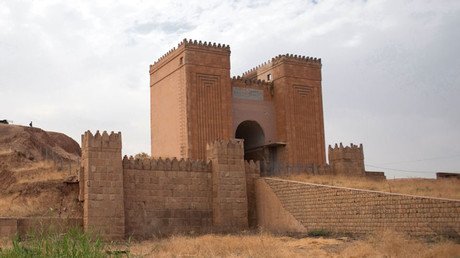ISIS blows up landmark Grand al-Nuri mosque with leaning minaret in Mosul - Iraqi military
The historical mosque in the Old City was particularly famous for its leaning minaret. It has now been destroyed, Reuters reported on Wednesday, quoting an Iraqi military statement.
"The Daesh [Arabic term for IS] terror gangs committed another historical crime by blowing up the al-Nuri mosque and its historical al-Hadba minaret," the statement read.
Footage capturing moment #ISIS detonated al-Hadba Minaret in #Mosul. pic.twitter.com/EpQZ1ShjhF
— Mustafa Al-Khaqani (@Khaqani_M) 21 июня 2017 г.
The US Central Command called the destruction of the mosque a "crime against the people of Mosul and Iraq." Centcom said ISIS was solely responsible for the destruction of the landmark, as American forces vowed to bring the terrorists to justice.
Full statement from Coalition on destruction of Nouri Mosque. "Responsibility for this devastation is laid firmly at the doorstep of ISIS." pic.twitter.com/YZVov95tqG
— Samuel Oakford (@samueloakford) June 21, 2017
"As our Iraqi Security Force partners closed in on the al-Nuri mosque, ISIS destroyed one of Mosul and Iraq's great treasures," said Maj. Gen. Joseph Martin, Commanding General of Combined Joint Forces Land Component Command-Operation Inherent Resolve. "This is a crime against the people of Mosul and all of Iraq, and is an example of why this brutal organization must be annihilated."
IS responded through it's propaganda wing Amaq, and blamed a US airstrike for the mosque’s destruction.
Iraqi troops storm west Mosul’s ISIS-held Old City https://t.co/gjEoNncDHh
— RT (@RT_com) June 18, 2017
The demolition occurred as forces from Iraq's elite Counter Terrorism Service made their way to within 50 meters (164 ft) of the mosque, according to the statement. Officials had been hoping to recapture the historic building before the end of the holy month of Ramadan.
The landmark structure, built in the 12th century, was where IS leader Abu Bakr al-Baghdadi had declared the Islamic caliphate soon after it occupied the Iraqi city in 2014 and the black flag of IS had been flying from the minaret ever since.
IS’ occupation of Mosul coincided with reports of civil resistance against the terrorist group, with residents reportedly having saved the mosque by forming a human chain around it.
The US-backed operation to retake Mosul from the terrorist group was launched over 8 months ago. Earlier this week, Iraqi forces pressed into the Old City where the remaining jihadists have been holed up, with air support from the US-led coalition and backed up on the ground by Shiite militias and the Kurdish peshmerga.
Around 100,000 civilians are still trapped in the area, according to UN estimates.
READ MORE: ‘Excessive risk’: Leading NGOs unite to criticize Mosul bombing campaign
The terrorist group has infamously destroyed a number of architectural gems of world importance in the Middle East. Jihadists have devastated the ancient city of Palmyra in Syria, with their brutal acts having been described as "a new war crime and an immense loss for humanity" by UNESCO.
READ MORE: Smash, bulldoze, erase: ISIS releases new video of Palmyra antiquities’ destruction
IS has also demolished a 2,000-year-old Gate of God near Mosul, with the structure having been documented as an artifact from the ancient Assyrian city of Nineveh.
